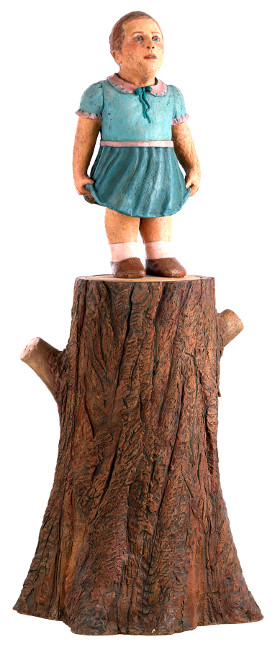 A museum patron expects to find informative signage near an artwork., including biographical information about the artist, a description of the piece's historical context, or critical acclaim. Instead, the placard near the Marlene Miller sculpture Girl 1 - currently on display in the Figge Art Museum's Waxing Poetic show - reads: "what gestates in the roots unseen / reveals herself as tall on the inside / grown whole-sprung from a trunk / full of well manners & bluest eyes / puzzled by where she comes from."
A museum patron expects to find informative signage near an artwork., including biographical information about the artist, a description of the piece's historical context, or critical acclaim. Instead, the placard near the Marlene Miller sculpture Girl 1 - currently on display in the Figge Art Museum's Waxing Poetic show - reads: "what gestates in the roots unseen / reveals herself as tall on the inside / grown whole-sprung from a trunk / full of well manners & bluest eyes / puzzled by where she comes from."
This pairing of a visual work with a poem highlights how we assign meaning to art. In his words, Ryan Collins captures the literal appearance of the work- referencing the tree trunk, the girl's intensely blue eyes, and her polite but befuddled posture and expression.
But it also reads the sculpture. "Grown whole-sprung" and "tall on the inside" refer to the aged and androgynous face, contrasted with the child's body: The texture of the head is chunky and scratchy, as opposed to the smoothness of the body. Collins imagines the sudden appearance of this creature, enhancing our view of it without dictating a specific interpretation.
The exhibit - running through October 7 - is less about the artworks as stand-alone objects than about the process of inferring meaning. In addition to artworks matched with poetry in specific response to them, viewers are invited to create their own written reactions. At the center of the exhibit is a writing table with pens and paper, and under each work is a hanging packet of collected visitor responses. The technologically inclined are prompted to Tweet their responses to designated hashtags.
Amelia, 15, at a Weight-Loss Camp by Lauren Greenfield seems to be a straightforward photographic portrait. The girl is slightly off-center, with her face and upper torso filling the composition. She stares at the viewer, looking mostly blasé, with one eyebrow slightly raised. She has precisely applied makeup, and a tank top with the word "Sugar" emblazoned in red.
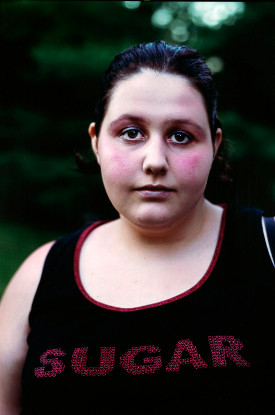 The accompanying poem, "Femme" by Neal Allen, is a girl's point of view on the culturally enforced connection between sexuality and being "grown up." When viewed next to the photograph, one can imagine Amelia herself writing the words: "I've learned myself / how to anoint my ears, / the slit between my breasts / with the musk of sugar, / the musk of spice." It is clear that the girl longs to feel beautiful, with her coy expression and careful makeup, but her overweight body and participation in a weight-loss camp suggest this is a struggle. Her shirt brings the point home; the word "sugar" often suggests sexuality but is ironic on a person trying to control her weight.
The accompanying poem, "Femme" by Neal Allen, is a girl's point of view on the culturally enforced connection between sexuality and being "grown up." When viewed next to the photograph, one can imagine Amelia herself writing the words: "I've learned myself / how to anoint my ears, / the slit between my breasts / with the musk of sugar, / the musk of spice." It is clear that the girl longs to feel beautiful, with her coy expression and careful makeup, but her overweight body and participation in a weight-loss camp suggest this is a struggle. Her shirt brings the point home; the word "sugar" often suggests sexuality but is ironic on a person trying to control her weight.
Another photograph, Barnum & Bailey Dressing Rooms by Louis Faurer, illustrates the gap between a performer as a person and as a character. This black-and-white image from 1950 shows a man in full clown regalia, including a papier-mâché tiger supported by a thin rod attached at his waist. This would be an enjoyable illusion were the clown running about in a fictional panic, but it looks lifeless when attached to a still man standing backstage.
Faurer's photo has two accompanying poems: "Pucker Up, Tiger" by E. Marie Bertram and "Circus Haze" by Shea Doyle. While the photo itself presents this behind-the-scenes look at the circus through an objective lens, the poets describe it from the perspective of the performers.
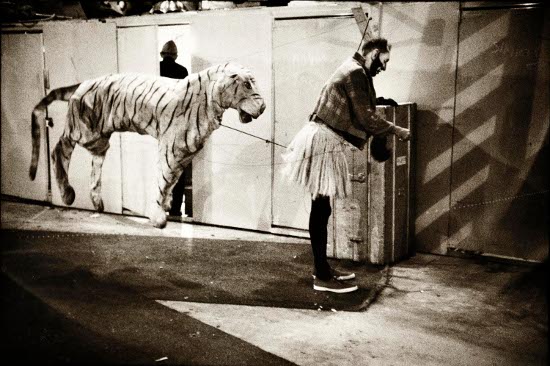
Written in second person, Bertram's poem imagines the bittersweet rush of performing through the clown's connection to his prop tiger: "You'd mash / Your red showman's lips against her papier-mâché pout long enough to feel / The weight of your hollow bodies." Doyle writes of the connection of the performer to the spectators: "who could blame them / confusing what was real and what was not / suspending all belief so the audience would too." All three works propose that the inherent sadness in happy fiction is that it is not reality, yet it is valuable nonetheless.
Tidings by Romare Bearden establishes an emotional arc through the use of found imagery employed in a screen print. This 1971 work shows two women in the foreground to the right, in a loose embrace, with one holding a flower. They appear emotionless, with hard-to-read expressions, as Bearden has rendered their faces in deep shadow. In the distance, we see an anachronistic steam-engine train, dilapidated buildings, a modern road with painted lines, and bare trees among a rolling landscape. A rainbow emerges from the chimney of a building on the right but fades into a black cloud in a flat gray sky.
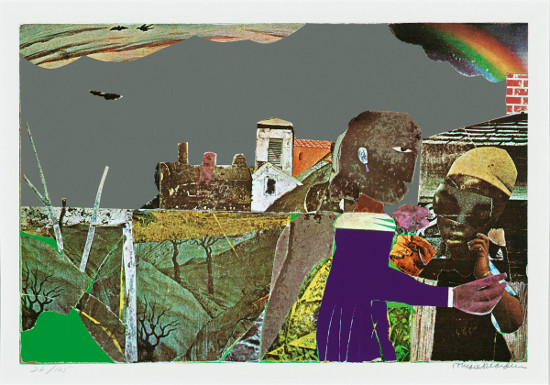
The train suggests travel, although the situation of the women is ambiguous. Are they coming together, or about to part? What tidings, or news, are the women hearing? Bearden has included images of hope - a flower, the rainbow, and birds flying in the distance - but they seem crushed under the dull colors and intense black cloud.
Tidings seems a narrative of living day by day in the shadow of fading hope - pragmatic and depressing. Shea Doyle captures this tone in her accompanying poem, "Hello Sweetheart," in which she takes on the voices of these women: "we are not meant for this world / it lacks imagination / and traffics in lost dreams / when we have the sky / in all its empty beauty."
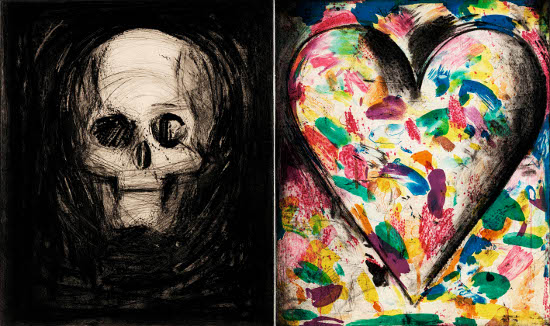
Jim Dine's Sovereign Nights also contrasts emotions, but through juxtaposed symbols. The composition is divided in half with a precise white line, and the left side of the etching is a skull, centered in a void of darkness. Scratchy, curving gray marks break up the background space, providing texture. The shading on the skull is similarly scratchy and hurried in appearance. The right half is filled with an iconic heart shape. Its surface, as well as the background, is full of finger-paint-like smudges, and smears of brightly-colored ink.
This work invokes love and death on the surface, but digging deeper, it is an analysis of symbolism. The images of the skull and heart have been used for centuries, to the point of being beyond cliché. The accompanying poem by Catie Osborn calls this out right away, starting: "It seems like a terrible poetic nightmare / to write a poem comparing death and love / because everyone does that." She then goes on to write about dinosaurs and the Batmobile before addressing the heart and skull themselves.
These seemingly unrelated associations (love is like the Batmobile?) are an example of the pleasantly subjective nature of art interpretation. Although art will most always have a theme, and a message to varying degrees of elusiveness, each viewer will ultimately decide its meaning. While one person sees a heart and thinks of a spouse, another may be reminded of pizza, or even the Batmobile. Dine uses symbolism so obvious that is forces these idiosyncratic, subconscious links.
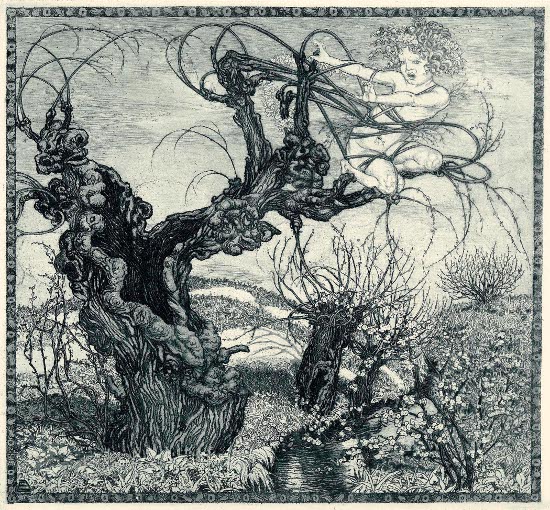
The engraving The Captured Spring by Ella Traugi and the accompanying poem, "Genesis" by Neal Allen, explore how viewers interpret an action-infused narrative image without context. We see a young nude woman caught in the gnarled branches of a leafless tree. The background is two hills, leading our eyes downward to three flowered bushes also in the foreground. The intricate detail in the bushes and grass balance the smooth, light-valued sky. The flow of action in the composition shoots to the top right, drawing our eyes to the woman, but the branches whip back down, creating a dizzy, swirling visual path.
The menacing tree has a gaping void in its center, and appears to be pulling the woman toward this opening. The woman fights against the branches, with tense muscles and a defiant face. Short branches writhe throughout the composition, infusing it with anxious motion. The image is black-and-white, with short hatching lines adding tonal shifts. Although mostly realistic in style, Traugi has exaggerated the texture of everything, enhancing the smoothness of the woman's flesh against the roughness of the bark.
Although clearly a dramatic scene, Traugi has given no indication of who is winning, or the specifics behind the conflict. Do the bare trees need to capture spring to bloom, or does spring force them out of hibernation? The tree seems the antagonist, as it is dark, large, and monstrously gnarled. However, the woman does not fit the traditional role of "damsel in distress," with her muscular frame and warlike glare. The viewer is not aware of a particular setting, with no architecture, clothing, or props present.
When confronted with only part of a story, our inclination is to connect the dots. Allen does this, making a poetic myth: "She did a dance / to make the rains come." Later, Allen verbalizes the struggle's intensity and ambiguity: "She reached and twisted / her fingers in the vines to hoist - / or were the vines fingers / twisting around her hands / to hoist her up?"
This interpretation reminds us of the simple joy of making up stories - like a pre-literate child "reading" a book based only on its pictures.
Michelle Garrison is a mixed-media artist who teaches art and design at Geneseo Middle School. She can be reached at michelle_m_garrison@hotmail.com.










